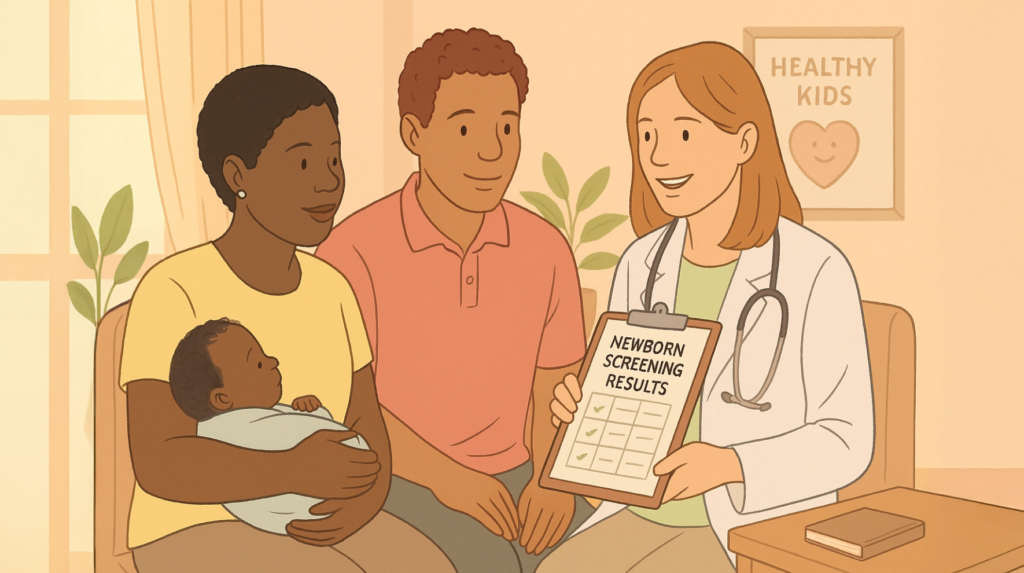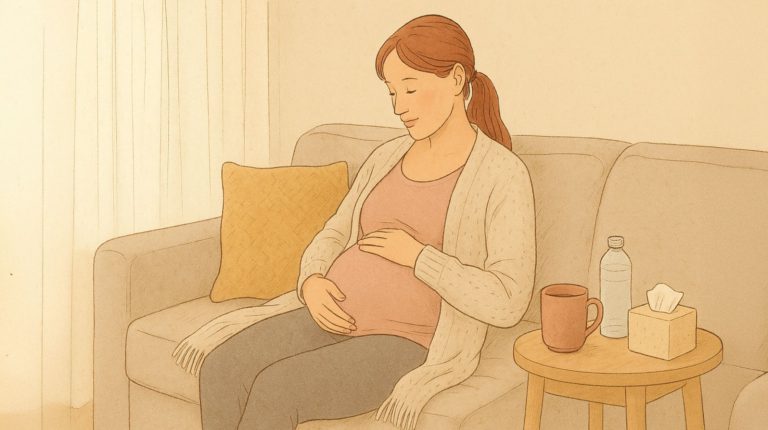Welcoming a new baby comes with endless moments of wonder from that first cry to the gentle curl of tiny fingers around yours. In those early days, every detail feels precious, and as parents, all you want is to know your little one is healthy and thriving.
That’s exactly what newborn screening helps confirm. Within the first days of life, a few simple tests can give doctors valuable insights into your baby’s health often before any symptoms would ever appear.
Think of it as an extra layer of reassurance, ensuring that if something does need attention, it’s caught early and treated quickly. This guide will walk you through the tests, what’s considered normal, and the steps that follow.
Also, this blog features expert insights from Carey Chronis, MD, FAAP, Pediatrician at Dr. Carey’s Baby Care and Kiara DeWitt, a certified Pediatric Nurse.
What is NBS (Newborn Screening)?
Newborn Screening, often called NBS, is a nationwide health program that checks babies 24 – 48 hours after birth for rare but serious conditions. Using just a few drops of blood from a quick heel prick, doctors can look for dozens of metabolic, hormonal, and genetic disorders that aren’t visible at birth but can be managed if caught early.
“ Parents who feel under-informed should start with a direct request: “Can you walk me through what was tested and why?” That single question invites a conversation that goes beyond paperwork.”
This life-saving program began in the 1960s, when researchers discovered that phenylketonuria (PKU) could be detected in newborns and treated through a special diet, preventing intellectual disability later in life. Today, NBS covers many more conditions, giving babies the best possible start.
What’s included in newborn screening tests?
Every state in the U.S. has its own newborn screening panel, but all programs check for a core group of serious, but treatable conditions. The following includes a list of conditions and how they are tested.
“ The goal is to detect diseases and treat them before damage can occur.”
Blood spot screening (heel prick test)
A few drops of blood are collected from your baby’s heel and sent to a state lab. This test checks for dozens of rare but serious conditions, including:
- Metabolic disorders – e.g., phenylketonuria (PKU), where the body can’t break down certain proteins.
- Hormonal conditions – e.g., congenital hypothyroidism, which affects growth and brain development.
- Blood disorders – e.g., sickle cell disease, which impacts red blood cells.
- Genetic conditions – e.g., cystic fibrosis and severe combined immunodeficiency (SCID), which affect lungs or immunity.
- Pulse oximetry screening (oxygen test)
A painless sensor is placed on your baby’s skin to measure oxygen levels. This helps detect critical congenital heart defects (CCHDs) that might not be obvious at birth. - Hearing screening
A small earphone or soft probe checks how your baby’s inner ear responds to sound. Early detection of hearing loss ensures babies can get timely support for speech and language development.
Some states go further and test for 60 or more conditions, while others focus on the federally recommended panel. You can check your state’s public health department website to see the exact list where you live.
Some states also require a second newborn screening between days 7 to 14, especially for conditions that may not appear right after birth. Make sure to ask if this applies to your location.
The important thing to know is that all the conditions on these panels are rare, serious, and treatable if found early often before symptoms show up.
“ Although newborn screening is universal, the tests performed from region to region can vary. Current screening includes many tests which are very rare. It is always good to ask for a list of what is being tested. Also, understanding who will contact you when results are available.”
What’s normal?
- It’s normal for newborn screening tests to occur within 1 to 2 days of birth, typically before hospital discharge. Some states require a second screen between 1 and 2 weeks of age for accuracy.
- Any blood collection site may show slight bruising or redness but generally heals quickly.
- A normal result means no indication of tested conditions; however, a second confirmatory test may follow if initial results are out of range.
“ Early detection can rewrite a child’s life trajectory in ways that are impossible to duplicate later. Conditions like congenital hypothyroidism, if addressed within the first few weeks, may allow normal growth and development with no visible deficits.”
What’s next if the result is abnormal?
First things first: an “abnormal” or “out-of-range” result does not mean your baby definitely has a condition. The first test is designed to be very sensitive so it sometimes flags babies who are completely healthy. Most of these results turn out to be false alarms after repeat or confirmatory testing.
Here’s what typically happens next.
When results come back
- In most states, initial newborn screening results are available within 5–7 days.
- If something is flagged, your pediatrician (or sometimes the state’s newborn screening program) will contact you directly, usually within a few days of testing.
Who contacts you?
- Your hospital’s newborn screening coordinator or your baby’s pediatrician will be the first point of contact.
- If urgent, a state public health nurse or metabolic specialist may also reach out.
What does “borderline” or “inconclusive” mean?
- Borderline/inconclusive simply means that the lab couldn’t get a clear answer. This could be due to the sample being collected too early, the baby being premature, or even just a technical issue with the blood spot.
- In these cases, the lab will ask for a repeat heel stick test to clarify results.
Why does a quick follow-up matter?
If a condition is confirmed (like PKU, congenital hypothyroidism, or MCADD), early treatment can start immediately. This often prevents complications entirely and allows your baby to grow up just as healthy as their peers.
Parent checklist while waiting
While you wait for follow-up testing or results, here’s what to do:
- Keep up with regular feeding – frequent, steady feeds help keep your baby’s energy balanced.
- Watch for illness like fever, vomiting, extreme sleepiness, or trouble feeding should be reported right away.
- Know your “red flag” signs like difficulty breathing, unresponsiveness, or persistent seizures are emergencies – call 911.
- Write down your questions so you’re prepared for your follow-up visit.
- Keep your contact info handy. Ensure your pediatrician and the state program have your best phone number.
False positives: What parents should know?
Hearing that your baby’s newborn screen showed an “abnormal” result can be one of the most stressful moments for new parents. But it’s important to understand that a screening test is not a diagnosis. These tests are designed to cast a wide net catching even the slightest possibility of a condition so that no baby who needs help is missed.
That means sometimes results will look concerning at first but turn out to be completely normal after follow-up testing. These are called false positives, and while they can cause understandable worry, they are an expected part of the process.
“ Although false positives are unavoidable, screening programs have adapted their testing methods to reduce needless worry. It is important to remember that a screening test is not diagnostic, rather, such testing is designed to detect those who may have a disease.”
In other words, a call for follow-up does not mean your baby is sick. It simply means the test is doing its job. Most babies who need further evaluation are found to be completely healthy, and for the few who do need treatment, the early warning makes all the difference.
Conclusion
Newborn screening is truly one of the most powerful tools we have to protect babies’ health.
The NBS program, guided by the Recommended Uniform Screening Panel (RUSP), continues to expand, ensuring more comprehensive coverage for babies nationwide.
While words like “abnormal” or “inconclusive” can sound overwhelming, remember that most flagged results turn out to be false alarms. The process is designed to be cautious, so no baby who needs help is missed. What matters most is staying calm, following up quickly, and knowing that your care team is there to guide you through each step.
By understanding how newborn screening works, you’re taking an active step in safeguarding your baby’s future. And that peace of mind is worth everything.
FAQs
Q: 1. How should I prepare as a parent?
A: As a parent, the focus should be on being informed by understanding which conditions are screened, how results will be shared, and who to contact for any questions or concerns.
Q: 2. Does my baby need a second newborn screen?
A: Some states require a second screening around 7 – 14 days after birth, especially for conditions that may not appear immediately. Ask your pediatrician if this applies in your state.
Q: 3. Will the tests affect breastfeeding or bonding time?
A: No. The screenings are quick and can be done right in one’s room. The baby can return to feeding and snuggling immediately afterward.
Q: 4. Can I refuse only part of the screening, like just the heel prick but not the hearing test?
A: Policies vary by state. In some places, parents can refuse certain parts, though doctors strongly recommend completing all three tests for full protection.
Q: 5. What should I do if I don’t hear back about the results?
A: It’s important not to assume everything is fine. It is highly recommended to follow up with a pediatrician or hospital for confirmation.
Q: 6. Will the results go into my baby’s permanent medical record?
A: Usually yes, but the storage of samples and records depends on state or country policies. Parents can ask about privacy and storage rules.
Q: 7. Can results ever change as my baby grows?
A: No, the initial results don’t change, but conditions may show up later if a baby wasn’t screened for them. That’s why some states do second screens at 1 – 2 weeks.
Q: 8. Can siblings of a baby with an abnormal screen be affected too?
A: Sometimes. Many conditions are genetic. If a condition is confirmed, doctors may recommend testing siblings as well.
Sources:
- Serious, but treatable conditions. NCBI. 2023. Newborn Screening
- Questions to ask. Health Resources and Services Administration. Newborn Screening Process
- Federally recommended panel. Health Resources and Services Administration. Recommended Uniform Screening Panel
- Screening for PKU. National Human Genome Resource Institute. First Screen for Metabolic Defect in Newborns
- How is newborn screening done?. Immune Deficiency Foundation. Newborn Screening




